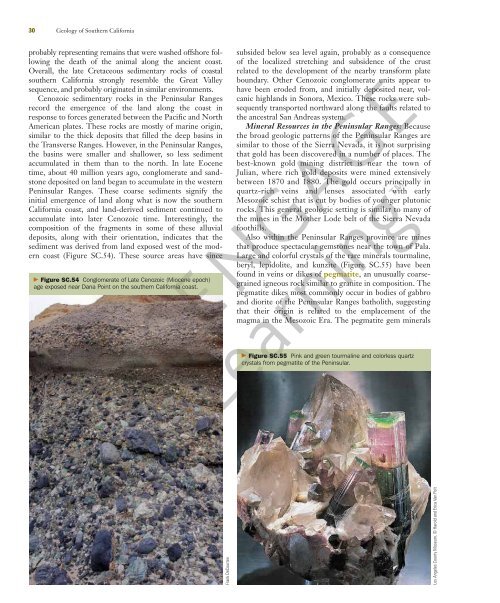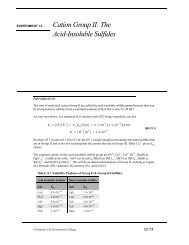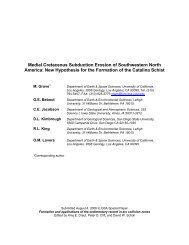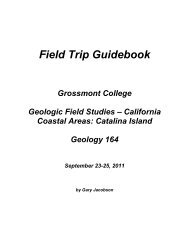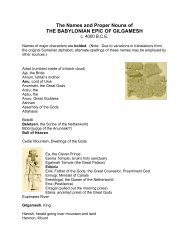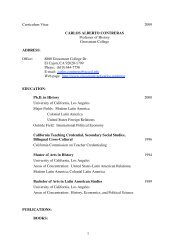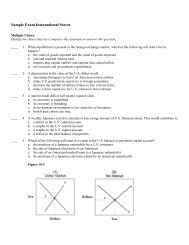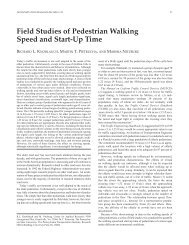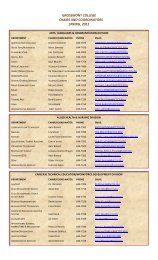Geology of Southern California.pdf - Grossmont College
Geology of Southern California.pdf - Grossmont College
Geology of Southern California.pdf - Grossmont College
You also want an ePaper? Increase the reach of your titles
YUMPU automatically turns print PDFs into web optimized ePapers that Google loves.
30 <strong>Geology</strong> <strong>of</strong> <strong>Southern</strong> <strong>California</strong><br />
probably representing remains that were washed <strong>of</strong>fshore following<br />
the death <strong>of</strong> the animal along the ancient coast.<br />
Overall, the late Cretaceous sedimentary rocks <strong>of</strong> coastal<br />
southern <strong>California</strong> strongly resemble the Great Valley<br />
sequence, and probably originated in similar environments.<br />
Cenozoic sedimentary rocks in the Peninsular Ranges<br />
record the emergence <strong>of</strong> the land along the coast in<br />
response to forces generated between the Pacific and North<br />
American plates. These rocks are mostly <strong>of</strong> marine origin,<br />
similar to the thick deposits that filled the deep basins in<br />
the Transverse Ranges. However, in the Peninsular Ranges,<br />
the basins were smaller and shallower, so less sediment<br />
accumulated in them than to the north. In late Eocene<br />
time, about 40 million years ago, conglomerate and sandstone<br />
deposited on land began to accumulate in the western<br />
Peninsular Ranges. These coarse sediments signify the<br />
initial emergence <strong>of</strong> land along what is now the southern<br />
<strong>California</strong> coast, and land-derived sediment continued to<br />
accumulate into later Cenozoic time. Interestingly, the<br />
composition <strong>of</strong> the fragments in some <strong>of</strong> these alluvial<br />
deposits, along with their orientation, indicates that the<br />
sediment was derived from land exposed west <strong>of</strong> the modern<br />
coast (Figure SC.54). These source areas have since<br />
� Figure SC.54 Conglomerate <strong>of</strong> Late Cenozoic (Miocene epoch)<br />
age exposed near Dana Point on the southern <strong>California</strong> coast.<br />
Frank DeCourten<br />
subsided below sea level again, probably as a consequence<br />
<strong>of</strong> the localized stretching and subsidence <strong>of</strong> the crust<br />
related to the development <strong>of</strong> the nearby transform plate<br />
boundary. Other Cenozoic conglomerate units appear to<br />
have been eroded from, and initially deposited near, volcanic<br />
highlands in Sonora, Mexico. These rocks were subsequently<br />
transported northward along the faults related to<br />
the ancestral San Andreas system.<br />
Mineral Resources in the Peninsular Ranges: Because<br />
the broad geologic patterns <strong>of</strong> the Peninsular Ranges are<br />
similar to those <strong>of</strong> the Sierra Nevada, it is not surprising<br />
that gold has been discovered in a number <strong>of</strong> places. The<br />
best-known gold mining district is near the town <strong>of</strong><br />
Julian, where rich gold deposits were mined extensively<br />
between 1870 and 1880. The gold occurs principally in<br />
quartz-rich veins and lenses associated with early<br />
Mesozoic schist that is cut by bodies <strong>of</strong> younger plutonic<br />
rocks. This general geologic setting is similar to many <strong>of</strong><br />
the mines in the Mother Lode belt <strong>of</strong> the Sierra Nevada<br />
foothills.<br />
Also within the Peninsular Ranges province are mines<br />
that produce spectacular gemstones near the town <strong>of</strong> Pala.<br />
Large and colorful crystals <strong>of</strong> the rare minerals tourmaline,<br />
beryl, lepidolite, and kunzite (Figure SC.55) have been<br />
found in veins or dikes <strong>of</strong> pegmatite, an unusually coarsegrained<br />
igneous rock similar to granite in composition. The<br />
pegmatite dikes most commonly occur in bodies <strong>of</strong> gabbro<br />
and diorite <strong>of</strong> the Peninsular Ranges batholith, suggesting<br />
that their origin is related to the emplacement <strong>of</strong> the<br />
magma in the Mesozoic Era. The pegmatite gem minerals<br />
� Figure SC.55 Pink and green tourmaline and colorless quartz<br />
crystals from pegmatite <strong>of</strong> the Peninsular.<br />
Los Angeles County Museum, © Harold and Erica Van Pelt


